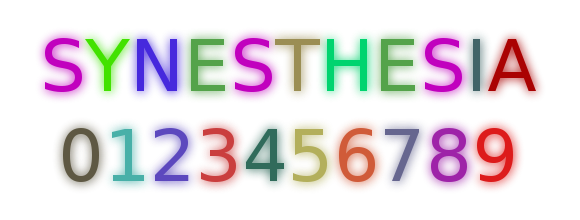Today’s blog post is about synaesthesia and how it can be useful for language learning. Synaesthesia is basically the condition in which people, when being confronted with a sensory stimulus, e.g. a written text or when hearing sounds, automatically and involuntarily experience a sensory stimulus in a different sensory pathway. There are different forms of synaesthesia, the most common one being the grapheme-color synaesthesia, another common one the association of sounds with colors (chromesthesia). It is said that about 4% of the population experience synaesthesia. To give an example, when a synaesthete with grapheme-color synaesthesia sees a written word, they will involuntarily and automatically “see” or associate the individual letters of the word with a specific color, which is usually fixed and will always be the same. For example for me personally, the letter “A” is always dark blue, “R” is always black, “O” white and “S” salmon red, even though the shades of a letter can blend into the shade of the following or previous letter in a word, quite like a rainbow painted in watercolor. So each word will leave behind a sort of “rainbow trace”/color sensation in one’s memory. The color sensations each letter evokes are, however, specific to each person, so each synaesthete will have their own color associations for each letter or grapheme. This is particularly useful when one wants to memorize long phone numbers for even if one doesn’t remember each single digit of the number in question, one is often able to ‘reconstruct’ the correct numbers with the aid of the color trace it left behind in your memory. For instance, if your association for the number 3 is always red and green for the number 2, when you don’t remember a particular sequence in your phone number, but still do remember that it was somehow reddish or greenish in the middle of your “rainbow sequence” you can make a good guess that the digits must be these two numbers. This also works for memorizing vocabulary when you learn a new language, even though to a lesser extent than with phone numbers.
Another form of synaesthesia is chromesthesia, the association of sounds with color sensations. So when hearing a particular language, this will trigger certain specific color sensations in me which I have for this particular language. For example, Spanish triggers strong reddish-orangeish-yellowish color sensations in me when hearing it, whereas Polish triggers shades of black, white, grays, ochres and browns, Greek shades of ochres, orange and greens, and Russian black, white and shades of blue. I therefore associate each language I speak with a particular color sensation or color feeling I get when I hear it and I also like and prefer, or even dislike, particular languages just because of these sensations they spark, because some languages trigger a pleasant “color harmony” whereas others really trigger a jarring, unpleasant “color sensation”.
For me as a language learner this means that my synaesthesia makes me a highly visual learner who needs colors and pictures to be able to memorize vocabulary. Each letter of a word has a specific fixed color for me, and each word as a whole leaves a certain “rainbow sequence” in my memory (the colors of the individual letters can blend into each other so that they get slightly modified from their “fixed” shade, e.g. a “black” letter can turn to dark brown or dark blue depending on the letters that surround it – just like in a watercolor painting 🙂 ), so that I can sometimes reconstruct a word I don’t remember precisely any more but of which I still vaguely remember its color or rainbow sequence. So I actively use and reinforce my synaesthesia when learning a new language. By contrast, language learning methods based on totally ‘abstract’ memorization techniques don’t work for me at all.



